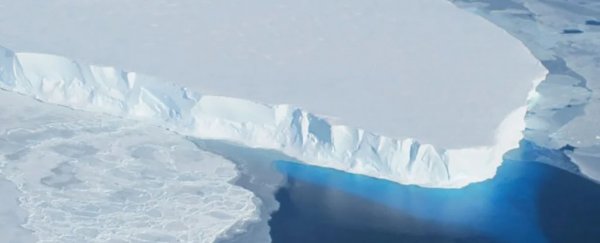A crucial ice shelf on Antarctica's Thwaites Glacier is on track to collapse within five years, accelerating the melting of the notorious 'doomsday glacier'.
Thwaites, which is the size of Florida, is already melting quickly, losing about 50 billion tons of ice per year. The glacier earned its grim nickname because its total collapse would raise global sea levels by about two feet and expose other Antarctic glaciers to the same melt process.
While scientists don't expect that catastrophe for at least 200 years, ice melt from Thwaites currently fuels about 4 percent of annual sea-level rise. Rising ocean levels can cause flooding in coastal areas that are home to millions of people and many of the world's largest cities, damaging property and infrastructure, and leading to more catastrophic storms.
For now, Thwaites's eastern region is somewhat stable, melting more slowly than the rest of the glacier. That's because an ice shelf – a floating extension of the glacier propped up on an underwater mountain – shields it from warm ocean waters and holds the glacier in place.
"As it's structured right now, this ice shelf acts like a dam. But it's not going to for very long," Erin Pettit, a glaciologist at Oregon State University, said in a press briefing at the meeting of the American Geophysical Union on Monday.
Cracks are spiderwebbing across the protective eastern ice shelf, which is likely to disintegrate into hundreds of icebergs within the next five years, "like the shattering of your car's window," Pettit said.
Once that happens, a wider stretch of ice from the landlocked Thwaites Glacier will be flowing into the ocean – melting into water, calving away from cliffs, or breaking off as icebergs.
Thwaites is changing rapidly – and getting more dangerous
It's unsettling to see new satellite images of the eastern ice shelf each week, Pettit said, adding, "Each new satellite image we get, we see deeper and longer fractures."
Pettit and her team are monitoring the ice shelf as part of the International Thwaites Glacier Collaboration (ITGC), a team of nearly 100 scientists. The US National Science Foundation and UK Natural Environmental Research Council have deemed Thwaites so important to immediate sea-level rise that they gave the collaboration US$25 million to study the glacier over five years.
As they near the midpoint of their five-year project, the ITGC scientists' data reveal a glacier growing increasingly volatile.
"There's going to be a dramatic change in the front of the glacier, probably within less than a decade," Ted Scambos, a senior research scientist leading Pettit's team, who called in from Antarctica's McMurdo Station, said during the briefing.
"It may still take a few decades before some of the other processes that accelerate the ice flow and the retreat take hold. It will, though, accelerate the pace and effectively widen the dangerous part of the glacier."
If the ice shelf doesn't shatter, it will come unmoored
As the critical eastern ice shelf fractures, warming ocean waters are melting it from below. The diminishing ice is slowly pulling away from the underwater mountain that props it up against the Thwaites glacier.
Within a decade, Pettit said, the ice will completely lose its grip on the undersea mountain. Her team thinks the fracturing will completely shatter the ice shelf before that, but it's hard to be sure.
Either way, once the ice shelf collapses, the new exposure to warm ocean waters could triple the speed of ice loss in the eastern third of Thwaites. That will send new volumes of water and ice pouring into the ocean each year, growing Antarctica's contribution to rising seas.
The researchers are not sure how quickly that acceleration will happen. It could take decades, or it could take centuries, Pettit said.
"It's daunting. It's a bit unsettling, especially standing on the ice and looking onto the ice sheet, and seeing that this huge area from one side of the horizon to the other is moving at you at about a mile every year," Scambos said.
"All by itself, this one glacier is big enough to impact sea level significantly."
This article was originally published by Business Insider.
More from Business Insider:
